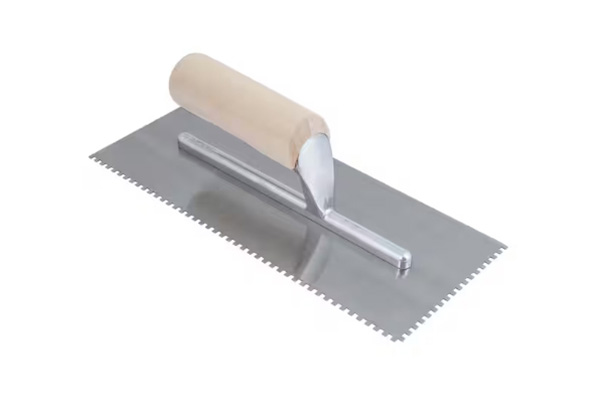A square notch trowel is an essential tool in the world of construction and home improvement, especially in tile installation. While many types of trowels exist, the square notch trowel has a specific function that sets it apart from others, making it invaluable for certain tasks. This article will explore what a square notch trowel is, its primary uses, and why it’s important in specific construction projects.

What Is a Square Notch Trowel?
A square notch trowel is a hand tool used for applying and spreading adhesive or mortar onto surfaces. It features a rectangular-shaped, toothed edge that is specifically designed to create uniform grooves in materials like thin-set mortar, cement, or adhesive. These notches are typically evenly spaced and can come in various sizes, with the most common being 1/4-inch, 1/2-inch, or even smaller for more detailed work.
The distinctive feature of a square notch trowel is the shape of its teeth, which are square and straight, as opposed to the curved notches seen in some other trowels. These square notches allow for precise control over the thickness of the adhesive layer applied, ensuring an even distribution that is critical for successful tile installations.
Primary Uses of a Square Notch Trowel
1. Tile Installation
The most common use for a square notch trowel is in the installation of tiles. Whether you’re working with ceramic, porcelain, marble, or stone tiles, this tool is essential for spreading the adhesive (thin-set mortar) evenly across the substrate, such as a floor or wall. The notches create grooves in the adhesive, which allows the adhesive to grab onto the back of the tile better, improving its bond and ensuring a secure fit.
For larger tiles, such as those above 12 inches, a larger notch size (such as 1/2 inch) is usually preferred. Smaller tiles or mosaic installations often require a smaller notch size (like 1/4 inch) to ensure the adhesive is applied evenly without excess mortar spilling out.
2. Backer Board and Subfloor Installation
Square notch trowels are also used when installing backer boards, which are frequently used in wet areas like bathrooms or kitchens. These boards are installed on subfloors to provide a stable surface for tile adhesion. Applying a thin layer of mortar with a square notch trowel helps ensure that the backer board stays firmly in place, offering a flat and even surface for tile installation.
3. Mosaic Tiling
For mosaic tile installations, which require precision due to the small size of the tiles, a square notch trowel with smaller notches is ideal. The trowel allows the installer to control the amount of adhesive applied, ensuring that the tiny tiles stay in place and are perfectly aligned. The square notches ensure that the adhesive is applied uniformly, minimizing the chances of uneven gaps or tiling issues.
4. Grouting and Mortar Application
While the primary use of a square notch trowel is for spreading adhesive, it can also be used in applications requiring thin-set mortar or grout. This includes tasks such as repairing or leveling surfaces, patching drywall, or even for applications that require the filling of gaps and crevices in a surface before the tile is laid down.
5. Floor and Wall Surfaces Preparation
Before tiling, surfaces often need to be prepared to ensure proper adhesion. The square-notch trowel can be used to spread a layer of mortar or adhesive onto a floor or wall, smoothing out any irregularities and ensuring a strong bond between the substrate and the tile. This is especially important in areas with uneven floors or walls, where an even application of adhesive is necessary for a successful installation.
Why Choose a Square Notch Trowel?
1. Consistent Adhesive Thickness
One of the primary benefits of a square notch trowel is the consistent layer of adhesive it leaves behind. The teeth of the trowel create grooves in the adhesive, which helps ensure the correct amount of material is applied. This is crucial for tile installations because an uneven layer of adhesive can lead to poor bonding, tiles shifting over time, or an unprofessional finish.
2. Improved Tile Bonding
The notches in the trowel not only provide an even application but also improve the bond between the tile and the surface. The grooves allow air to escape, ensuring that the adhesive makes a firm and even contact with the back of the tile, which enhances the overall strength and longevity of the installation.
3. Versatility and Precision
Square notch trowels are highly versatile and can be used for various tasks, from tiling to applying adhesives for other materials. The precision of the tool allows professionals and DIYers to achieve a high level of accuracy, ensuring that each tile is laid with precision.
How to Use a Square Notch Trowel Effectively
Using a square notch trowel properly can make a big difference in the outcome of your project. Here are some tips for effective use:
-
Choose the Right Notch Size: Select the appropriate notch size based on the tile size and adhesive requirements. Larger tiles require deeper notches, while smaller tiles need shallower notches.
-
Apply the Adhesive in One Direction: For the best results, apply the adhesive in one direction, then drag the trowel at a 45-degree angle to ensure consistent depth and uniform grooves.
-
Work in Small Sections: Apply the adhesive to a small section at a time to prevent it from drying out before you place the tiles.
-
Maintain a Clean Trowel: Keep the trowel clean by wiping it off regularly to avoid excess adhesive buildup, which could affect the quality of the application.
Conclusion
A square notch trowel is an essential tool for anyone involved in tile work or surface preparation. Whether you’re a professional installer or a DIY enthusiast, this tool allows for precision, efficiency, and effective bonding when laying tiles. The even distribution of adhesive and the creation of grooves ensure that the tiles stay in place, reducing the likelihood of movement or shifting after installation. By choosing the right notch size and using the trowel correctly, you can achieve professional-quality results in any tiling project.
Post time: 4月-23-2025






